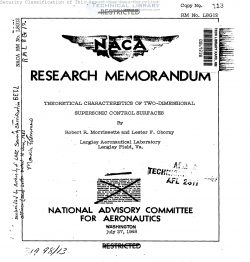naca-rm-l8g12
- Version
- 98 Downloads
- 2.24 MB File Size
- 1 File Count
- April 26, 2017 Create Date
- April 26, 2017 Last Updated
National Advisory Committee for Aeronautics, Research Memorandum - Theoretical Characteristics of Two Dimensional Supersonic Control Surfaces

In investigations of the aerodynamic characteristics of ailerons,
the influence of certain factors is not found in the predictions based
on a linearized solution. Higher-order solutions are therefore neces-
sary and consequently the analysis must be made 'for a two-dimensional
wing. The results are applicable not only to ailerons but to all types
of control surfaces.
Several methods are in use at this time for calculating the pressure
distribution over thin airfoils in a supersonic air stream. The
prevailing methods are: the graphical method of references 1 and 2, the
Ackeret thin—airfoil. theory, the Busemann second —order approximation
used in reference 3, and the power series of references 2 and 11- None
of these methods are exact as they do not consider the effect of the
boundary layer on the airfoil.
In this paper the Buseunann second-order approximation is used as
the best compromise because this approximation gives expressions which
are simple enough to be used in design work and which are probably as
accurate as could be expected of any method that—neglects the boundary-
layer thickness. The Busemam appmximation uses only the first two
terms of the power series found in references 2 and 11- Figures 2,12,
and 13 of reference 2 show that the first two terms of the power series
give results that are close approximations to the results obtained by
use of the oblique-shock equations and the isentropic -expansion and com-
pression equations. The method used herein is a closer approximation
than the Ackeret theory as the Busemann approximation takes into account
the effects of Mach number, airfoil thickness, and airfoil shape.-
The second-order approximation is limited to small angles and thin
airfoils- Reference 2 states that the theory used is not considered
accurate for Mach numbers less than approximately 1.3. This lower limit
has been used arbitrarily in this analysis. Also, the theory is not
good for Mach numbers below that at which the shock wave detaches-
Reference 2 gives values for the minimum Mach number for the existence of
an attached shock as a function of the flow—deflection angle.
| File | Action |
|---|---|
| naca-rm-l8g12 Theoretical Characteristics of Two Dimensional Supersonic Control Surfaces.pdf | Download |

Comment On This Post